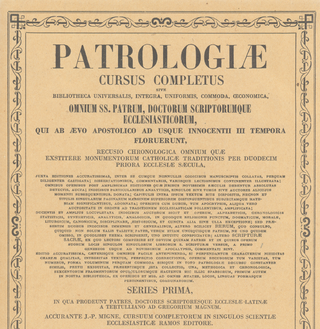
Germain was the bishop of Paris and is venerated as a saint in both the Catholic Church and the Eastern Orthodox Church. According to an early biography, he was known as Germain d'Autun, rendered in modern times as the "Father of the Poor".

According to Catholic lore, Trophimus of Arles was the first bishop of Arles, in today's southern France.

The Patrologia Latina is an enormous collection of the writings of the Church Fathers and other ecclesiastical writers published by Jacques-Paul Migne between 1841 and 1855, with indices published between 1862 and 1865. It is also known as the Latin series as it formed one half of Migne's Patrologiae Cursus Completus, the other part being the Patrologia Graeca of patristic and medieval Greek works with their medieval Latin translations.
Brunhilda was queen consort of Austrasia, part of Francia, by marriage to the Merovingian king Sigebert I of Austrasia, and regent for her son, grandson and great-grandson.

Caesarius of Arles, sometimes called "of Chalon" from his birthplace Chalon-sur-Saône, was the foremost ecclesiastic of his generation in Merovingian Gaul. Caesarius is considered to be of the last generation of church leaders of Gaul who worked to integrate large-scale ascetic elements into the Western Christian tradition. William E. Klingshirn's study of Caesarius depicts Caesarius as having the reputation of a "popular preacher of great fervour and enduring influence". Among those who exercised the greatest influence on Caesarius were Augustine of Hippo, Julianus Pomerius, and John Cassian.
Adrian, also spelled Hadrian, was a North African scholar in Anglo-Saxon England and the abbot of Saint Peter's and Saint Paul's in Canterbury. He was a noted teacher and commentator of the Bible. Adrian was born between 630 and 637. According to Bede, he was "by nation an African", and thus a Berber native of North Africa, and was abbot of a monastery near Naples, called Monasterium Niridanum.

The Abbey of Saint-Victor is a former abbey that was founded during the late Roman period in Marseille in the south of France, named after the local soldier saint and martyr, Victor of Marseilles.

The Diocese of Nice is a Latin diocese of the Catholic Church in France. The diocese comprises the Department of Alpes-Maritimes. The diocese is a suffragan of the Archdiocese of Marseille.

The former French Catholic Archbishopric of Arles had its episcopal see in the city of Arles, in southern France.
Rusticus of Narbonne was a monk of the Lérins Abbey and bishop of Narbonne and Catholic saint of Gaul, born either at Marseilles or at Narbonne.

The Diocese of Autun (–Chalon-sur-Saône–Mâcon–Cluny), more simply known as the Diocese of Autun, is a Latin Church diocese of the Catholic Church in France. The diocese comprises the entire Department of Saone et Loire, in the Region of Bourgogne.
Saint Syagrius was a bishop of Autun. His feast day is August 27.
William the Walloon was a Benedictine Abbot who served as the head of St. Arnoul at Metz in 1050. In 1073, he was elected as the Abbot of St-Remi, but faced persecution from the Archbishop of Reims and eventually resigned, returning to St-Arnoul. Twelve years later, in 1085, William allowed himself to be consecrated and took on the role of bishop in the See of Metz, but resigned and retired to the Abbey of Gorze the following year. He was later restored to his position at St-Arnoul by Bishop Herimann.
Gaul was an important early center of Latin Christianity during late antiquity and the Merovingian period. By the middle of the 3rd century, there were several churches organized in Roman Gaul, and soon after the cessation of persecution, the bishops of the Latin world assembled at Arles, in AD 314. The Church of Gaul passed through three crises in the late Roman period, Arianism, Priscillianism and Pelagianism. Under Merovingian rule, a number of "Frankish synods" were held, marking a particularly Germanic development in the Western Church. A model for the following Frankish synods was set by Clovis I, who organized the First Council of Orléans (511).
Gerard II, sometimes Gerard of Lessines, was the thirty-third bishop of Cambrai from 1076 and the last who was also bishop of Arras. He was a prince-bishop of the Holy Roman Empire, and his episcopacy coincided with the beginning of the Investiture Controversy between emperor and pope.
Richard de Millau (Milhau) was an 11th-century Cardinal and a major player in the Gregorian reform implemented in the South of France at the turn of the eleventh and twelfth centuries.

The Abbey of St. Symphorian, Autun, is a former abbey, later a priory, of Benedictine monks located outside the walls of Autun in Burgundy, France.
Saffaracus of Paris was a 6th century French bishop.
Saint Droctoveus was a Frankish abbot, the first abbot of what became Saint Germain-des-Pres in Paris.








